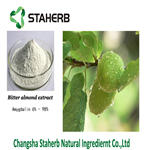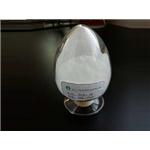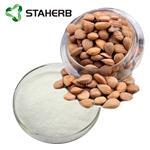- vitamin B17
-

- $275.00 / 1kg
-
2024-04-09
- CAS:29883-15-6
- Min. Order: 1kg
- Purity: 98% HPLC
- Supply Ability: 1000
- vitamin B17
-

- $260.00 / 1kg
-
2024-04-09
- CAS:
- Min. Order: 1kg
- Purity: 98%
- Supply Ability: 1000
- Amygdalin
-

- $270.00 / 1kg
-
2024-04-09
- CAS:29883-15-6
- Min. Order: 1kg
- Purity: 98% HPLC
- Supply Ability: no limitation
|
| | Amygdalin Chemical Properties |
| Melting point | 223-226 °C | | Boiling point | 563.27°C (rough estimate) | | alpha | -38.5 º (c=4, H2O) | | density | 1.4474 (rough estimate) | | refractive index | -40 ° (C=2, H2O) | | storage temp. | Sealed in dry,Room Temperature | | solubility | H2O: 0.1 g/mL hot, clear to very faintly turbid, colorless | | pka | 12.69±0.70(Predicted) | | form | Powder | | color | White to Off-white | | optical activity | [α]20/D 39±2°, c = 2% in H2O | | Water Solubility | 83 g/L (25 ºC) | | Merck | 14,597 | | BRN | 66856 | | Stability: | Hygroscopic | | InChIKey | XUCIJNAGGSZNQT-SWRVSKMJSA-N | | LogP | -2.237 (est) | | CAS DataBase Reference | 29883-15-6(CAS DataBase Reference) |
| | Amygdalin Usage And Synthesis |
| Uses and Synthetic Methods of Amygdalin | Amygdalin is a β-cyano-glycoside in the bitter almond that is bound to cyano (CN), which releases free cyano groups after eating the bitter almond, so that the food is poisoned. Amygdalin is a product of the metabolism of phenylalanine in the bitter almond. Amygdalin has β-glucosidase and amygdalinase (oxynitrilase): the former catalyzed amygdalin into two molecules of glucose and one molecule of amygdalenone through hydrolysis; the later catalyzes mandelonitrile into almond nitrile cyanide (HCN) and benzaldehyde through hydrolysis. Amygdalin exists in seeds, such as almonds.
Many plant root cells contain glycosides, with no toxic effect when in sugar type. Glycosides hydrolysis produce toxic substances leading to cell death. Mandelic glycosides contained in peach root is a glycoside. Amylose hydrolysis produce two kinds of plant toxins-hydrogen cyanide and benzaldehyde. Peeling root lesion formation and necrosis occurred in the vicinity of the stabbed nematode but not in contact zone; in addition, in vitro tests have proved that the pratylenchus penetrans can make amygdalin hydrolysis.
As a cyanide containing glucoside, it can be used as a substrate for such as maltase, almond casein and β-glucosidase identification, differentiation and characterization. | | Category | Toxic substances | | Toxicity classification | Highly toxic | | Acute toxicity | Acute toxicity Oral-Rat LD50: 522 mg/kg; Oral-mouse LD50: 443 mg/kg | | Flammability Hazardous properties | Combustible; producing toxic nitrogen oxides when heated. | | Storage and transportation | Ventilation, low temperature, drying | | Fire extinguishing agent | Dry powder, foam, sand, carbon dioxide | | Description | Amygdalin is a cyanogenic glycoside that has been found in seeds from plants of the Rosaceae family and has diverse biological activities. It induces cell cycle arrest at the G0/G1 phase, decreases cyclin A and Cdk2 levels, and inhibits cell growth in UMUC-3, RT112, and TCCSUP bladder cancer cells when used at concentrations ranging from 1.25 to 10 mg/ml. Amygdalin (3 mg/kg) reduces the number of primary microtubules and microvessels in aortic rings isolated from rats with diabetes induced by streptozotocin . In vivo, amygdalin reduces triglyceride, total cholesterol, and LDL levels and aortic sinus plaque area in an LDLR-/- mouse model of atherosclerosis. It also reduces production of TNF-α, IL-1β, and IL-6, as well as neutrophil and macrophage infiltration, in bronchoalveolar lavage fluid (BALF) in a mouse model of LPS-induced acute lung injury. | | Chemical Properties | WHITE FINE CRYSTALLINE POWDER | | Uses | Amygdalin, a cyanide containing glycoside, may be used as a substrate to identify, differentiate and characterize enzymes such as maltase(s), emulsin(s) and β-glucosidase(s). | | Uses | antiinflammatory, experimental antineoplastic | | Uses | A cyanogenic
glycoside occurring in seeds of Rosaceae, principally in
bitter almonds and peach and apricot pits. Some time ago it
was said to be effective in the treatment of cancer, but controlled
clinical trials repeatedly failed to confirm such claims. | | Definition | ChEBI: An amygdalin in which the stereocentre on the cyanohydrin function has R-configuration. | | World Health Organization (WHO) | Laetrile, which consists mainly of amydgalin, a glycoside
extracted from the kernels of apricots, peaches and other fruits, has been available
for over 30 years in preparations purporting to be beneficial in the treatment of
cancer. Although there is no evidence that these are efficacious, preparations
continued to be widely used and, until the late 1970s, they were considered to be
harmless. However, oral dosage forms, which may be broken down in the gut to
hydrogen cyanide, have subsequently been shown to be potentially lethal. This has
resulted in restrictive regulatory measures in several countries. | | General Description | This substance is a primary reference substance with assigned absolute purity (considering chromatographic purity, water, residual solvents, inorganic impurities). The exact value can be found on the certificate. Produced by PhytoLab GmbH & Co. KG | | Biochem/physiol Actions | Cyanogenic glycoside that is a component of bitter almonds and apricot pits. There is no scientific evidence that amygdalin itself is an effective anti-cancer agent. Recent studies using β?glucoside linked to a tumor-associated monoclonal antibody to release cyanide at the tumor cell has shown significant cytotoxicity. | | Safety Profile | Human poison by ingestion(infant data). Poison experimentally by ingestion. Anexperimental teratogen. Mutation data reported. Whenheated to decomposition it emits toxic fumes of NOx. | | Purification Methods | D-Amygdalin recrystallises from water as the trihydrate, or from EtOH. It is present in bitter almonds. [Smith Chem Ber 64 1115 1931, Beilstein 17/8 V 188.] |
| | Amygdalin Preparation Products And Raw materials |
|